A private train that once broke convenience

In the sump in the formation point near the Leningrad station.
October 3, 2006 from the Leningrad station left the first part of the "Megapolis". Launch dates depended on approvals, and tickets began to be sold in a hurry about a week, not 45 days before departure. There were no agreements with tourist groups, and the train in the schedule seemed just another one from St. Petersburg. He left for the first flight with a population of 19% - these were random passengers. In December 2006, a second train was added, and in May 2007 it was necessary to add cars: seven more were hitched to 10 passenger cars and a restaurant car, because there were a lot of passengers. They launched the second train along the same route.
Why did it happen? Because the train seemed like a fairy tale in 2006. It was made by people who know the railways deeply and often travel by trains. This is not a luxury class, but the maximum efficiency for earthly money. And as a result, a very large emphasis was placed on the human attitude to passengers.
The founders of the train were enraged by the lack of a duvet cover and the need for passengers to refuel the shelves themselves, and therefore all the shelves were immediately refueled (after the Megalopolis they began to do so later in the rest of the trains). It was enraging that in the morning the whole carriage rises along the switch with loud music. Enraged the need to hand over linen to the conductor and queues with it. Infuriating frightening toilets and much more.
Train concept
It turned out that all of the above are solvable things. Now many of them sound familiar, but then each was so shockingly new that you just look at how it was done and wonder why no one had done it before.
It was decided simply with the shelves: there were already standard cars 61-4179 and 61-4174 TVZ (coupe and SV, respectively), in which sofas turned into beds by lowering the back of the shelf. It turned out that you can lay a shelf and raise it. Will be needed - just omit it.
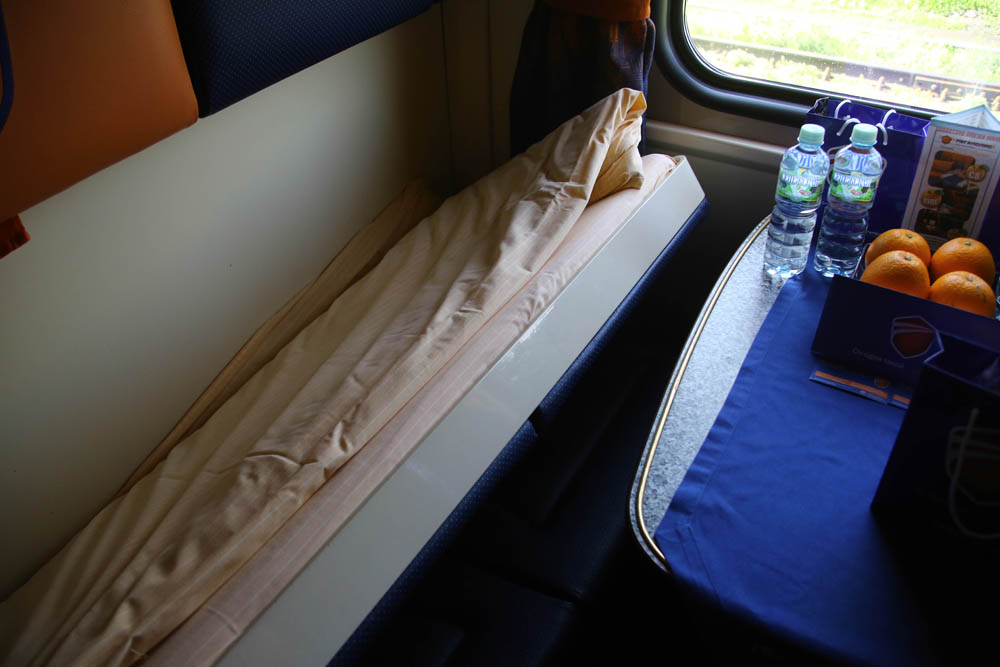
There is an obvious problem with a reserved seat (with side shelves), but they simply weren’t in this train. By the way, looking ahead, it was often possible to buy an economy coupe at a price, like a reserved seat on other trains (then it was Smena and Afanasy Nikitin).
It was enough to leave the laundry in place or simply push the back of the shelf back. There was no need to hand over anything. Handing over linen is necessary to take into account the fact that passengers have not stolen anything. Of course, passengers began to carry linen, especially towels (for some reason they came with a logo as souvenirs for both our fellow citizens and foreign tourists). On the one hand, the problem was solved by explaining that towels should be left on the train radio, and on the other, by the understanding that the service is still worth the loss. Although now, it happens, you can meet a person with a branded towel on his shoulder at the exit from the car.
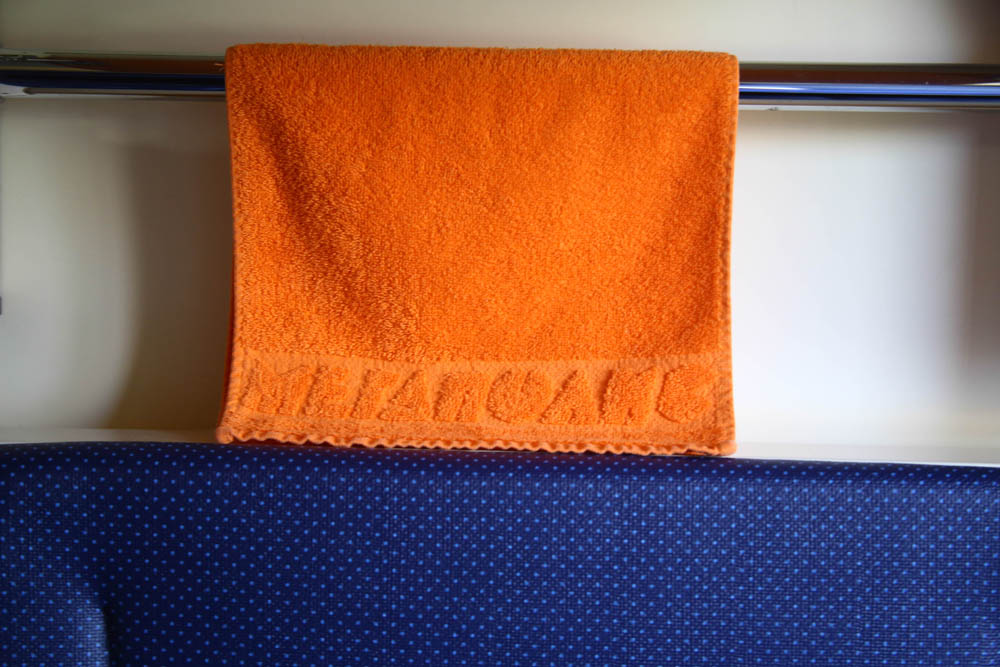
Changed the SLA to clean the toilet. Historically, at that time they were not cleaned at night. This meant that after midnight they turned into a pumpkin, and walking in the vestibule was somehow calmer and safer (we in no way urge you to repeat this experience). The conductor changes were distributed so that at night they still washed the toilets.
The general “Company, rise!” With the inclusion of light and sound was replaced with a special procedure. Then there was no electronic registration, and the conductor checked the tickets at the entrance, and then collected them on the car, going up to each passenger in his place. What gave rise to a joke about programmers and engineers. So, during this procedure, the conductor did four important things:
- Picked up a ticket.
- I introduced the passenger to the coupe and talked about the train.
- He asked when to wake up, and wrote down time in a notebook.
- Clarified whether to serve breakfast.
And in the morning, accordingly, he gently selectively woke everyone up in time. If necessary, immediately with breakfast.
At the same time, landing standards were introduced. Let me remind you, at some point of optimization on the railways, it was a good idea to put people through the wagon, that is, by making fewer entrances and putting one meeting conductor on two wagons. In practice, this sometimes turned out to be that if landing from one reserved seat to the second came across, then people with bags created huge traffic jams, cursed and sometimes even managed to fight. In Megapolis, however, a special procedure was developed for boarding - strictly following the guide to the carriage, and the guides also helped to bring things in, helped children and the elderly.
At the same time, quality standards on the most expensive trains were introduced through scripts of conductors. They also started here in a similar way, but it quickly became clear that passengers often travel the route repeatedly and often fall on the same guide. And generally speaking the same memorized phrases is strange. Therefore, they went from scripts to cheklistists: what should be mentioned and how. Being in a good mood and welcoming has become part of the ethics of the conductor. The guides, by the way, are motivated by money: if they do everything well and correctly, plus they learn the basic phrasebook in English or Chinese, then they get a higher class, and this is an increase in salary.
All this has already created the image of a train that wants to travel again. Therefore, quite a lot of people gathered who traveled from city to city for work. Until 2009, these were “casual” passengers, business travelers and actors who often went to their performances between the capitals. Around the end of 2008, tourist groups began to be added. And then our first economic crisis began. Then, many foreign trips were replaced by in-country tourism, and a variety of travelers got on the train.
But until we go further, it's time to talk about the composition itself and its features.

Composition and its features
Passenger cars are made on the basis of standard TVZ, between the sixth and seventh cars - there is always a restaurant based on the standard Wagonmash project (a plant from St. Petersburg that no longer exists). Purchased in 2006 and 2007. With the modernization, sockets and USB sockets appeared, the tambours and the compartment interior changed.
Thrust - Russian Railways. Machinists too. Wagons - their own, brigades - their own.
There are only two dining cars, and when one is displayed for maintenance, questions “From what?” From passengers appear.

The interior of the restaurant car.
There is a small reserve for passenger cars, and the length of the train can be reduced, so the overhaul of the past and this year in several iterations went seamlessly. But dining cars were being repaired in Novorossiysk due to the lack of their own Wagonmash.

All passenger cars - with Wi-Fi (a single network throughout the train), with an internal radio (playlists are recorded and broadcast) and with a regular intercom on the audio highway for urgent atypical announcements.
The train is based in a depot near the Leningradsky railway station, in the same place - the main base of service and formation. In St. Petersburg between flights it is located in a sump near the Moscow station. Heating of wagons - from the 3000 V line, which is everywhere along the Moscow-Petersburg route, generators operating from the rotation of the wheels are installed under the wagons, these are:

There is a DGU under the restaurant car - you need to start cooking before departure even in the depot sump.

You can see the tank with fuel and diesel generator set.
The fact is that in St. Petersburg there is a 3000 V trunk, but in Moscow it is not connected to the depot, and in winter coal heating works.

Good old coal boiler with electrical elements in the base.
Acid and alkaline standard batteries for TVZ wagons. “Brown” cars, for example, with acid batteries, and “white” cars with alkaline (these are the colors of the partitions in the interior of the cabin).
The train has transformer cars: their interior is made so that the upper shelves can be put into special niches so that they no longer be visible at all. Then the coupe turns into a CB. It can also be turned into a sedentary one with a flick of the wrist (legacy markings remained on the sofas, conditionally dividing them into three parts), but they never did so on the train.
Last and this year, a series of overhauls of wagons took place: replacement of chassis components, new batteries, modernization of the power supply network (USB!), New seat trim, and so on.
The train makes the only stop along the route in Tver for one minute. Nevertheless, at least one case is known in 13 years when a passenger got out and was a little lost (although there is a hypothesis that he got out because he changed his mind to go further).
What else attracted passengers?
We return to the success story of the train. Has already:
- Convenient schedule.
- Prices are not higher and not lower than the market.
- Very kind guides.
- Convenient service with respect for the passenger.
That is, there is no barrier to buying a ticket for money, and there is a good guide. As we know from the reviews on our site for different trains, this is very, very important, because even the most terrible train can differ markedly from car to car, depending on the personality of the conductor. That is, the main need - so that people feel like guests, and not a burden - was then satisfied.
Competition began with Strela, Afanasy and other trains. Nearby was the Grand Express train, which also did good service, but it was positioned as expensive and with all services included, so passengers almost did not overlap in interests.
Added business lounges for tickets. In fact, not all passengers use them (nevertheless, you can arrive on the train ten minutes before departure: this is not a plane), but the feature turned out to be very convenient. Now, by the way, when the business hall of the Leningradsky railway station is under repair, you can use the business lounges of the Kazan and Yaroslavl stations.
Another point of change was nutrition. Traditional trains are tied to common standards in it too. Then lunches in boxes, newspapers and sanitary kits could be given out. Megapolis added breakfast both on tickets and for an additional fee (in all cars), and this greatly changed the attitude of passengers. The restaurant car has become an important point of competition. It’s clear that it’s more expensive than “on the ground” (rather compared to St. Petersburg and not Moscow), but where else would you eat like that on a train?

By the way, in the background is a signature salad:

Business passengers realized that they would not only be fed, but fed tasty, and this would be included in the report as a ticket. There was always red caviar on a sandwich: it’s just a business card of a train.
Ordinary travelers tasted breakfast. In 2006, the metric was about a hundred breakfasts for "live" money from the train. This year it is lower, and a little later, when we get to the Chinese, I will tell you why.

Dishes in the closed part of the restaurant car.
A Peregrine Falcon appeared. Due to high-speed trains, the schedule has shifted. There was a departure at 00:20 from Moscow and 00:28 or 00:40 from St. Petersburg, arrival at 9 in the morning. In 2015, I had to leave St. Petersburg at 22:29 and arrive at 5:57 in the morning in Moscow. This changed the attractiveness of the train (actors and some business travelers disappeared almost immediately), and breakfast became irrelevant. Then they added dinner instead.
Another advantage that is available only to small carriers is the almost unbelievable flexibility. Megapolis could reassemble the composition for seasonal fluctuations in demand so as not to carry extra wagons (this is important for paying for the use of Russian Railways infrastructure). Standard tickets have common seasonal coefficients - a kind of set of magic constant factors based on previous years. Megapolis was able to build a dynamic scheme that very quickly changed the cost depending on the load of the train, that is, they made a good prediction of the population of the train for the next flights in the future for about a month.
In 2017, another optimization step took place: its own ticket offices appeared in St. Petersburg and Moscow. Prior to that, there was an agency agreement with the FPK for the sale of standard train ticket offices for a fee. Tickets at the box office are sold from the ACS "Express-3", that is, they work in the same API as ordinary passengers. About 90% of Megapolis tickets that fall into Express-3 are then taken online, and only 10% are taken at the physical box office. Moreover, a frequent case is right before departure.
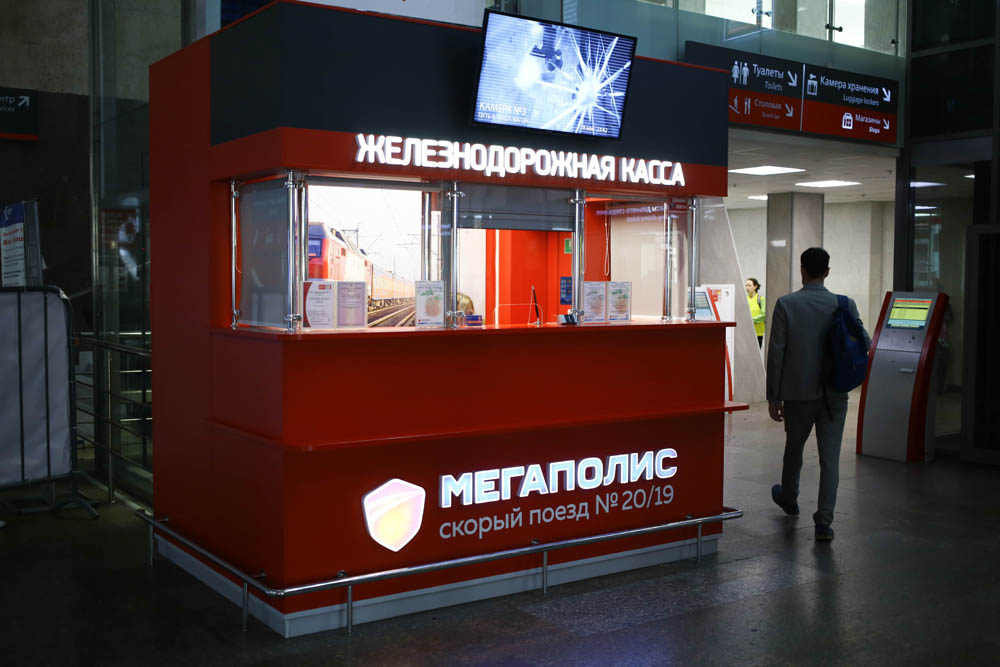
Cash desk at the Leningrad station.
Nevertheless, not all tickets get into Express-3. And there are nuances. The first group of tickets that simply do not reach the ACS is the blocks of travel agencies. This is very similar to the “charter” blocks for air transportation: they paid for the volume, guaranteed use — they received a discount for this. The second group of tickets outside the ACS is the reservation “for their own people”, that is, for club members, and technical reservation for seats in the staff carriage (in particular, for the carrier’s personnel). They are released a few hours before departure, if they have not been booked, and become available in the ACS "Express-3" at regular prices.
The train has its own club card: many people choose it only because of convenience (it is often much better to spend the night and have breakfast on the train than to fly tired by plane). It acts like an airline loyalty program: fill out an application, get it in your hands from the guide or by mail (if you filled out on the site outside the train), points are awarded for it (and you can restore the previous three months of travel). Maximum - 650 points, minimum - 160 points per trip, depending on the class of compartment. 1 point = 1 ruble. You can spend points on new trips, upgrades and bonus trips, partial write-offs are possible, it is not necessary to save for the whole trip. To spend points, you need to call the office of Megapolis. Most importantly, these four places “for their own” are held in armor until the last, that is, if you have a card and at least one point on it, you can order it from the reserve by phone. So, if you often travel between cities, then such a card can be a very good guarantee of a normal trip price today.
Let's go by train

Conventionally, in the Megapolis there is a coupe-economy and a business class. Here is the economy:
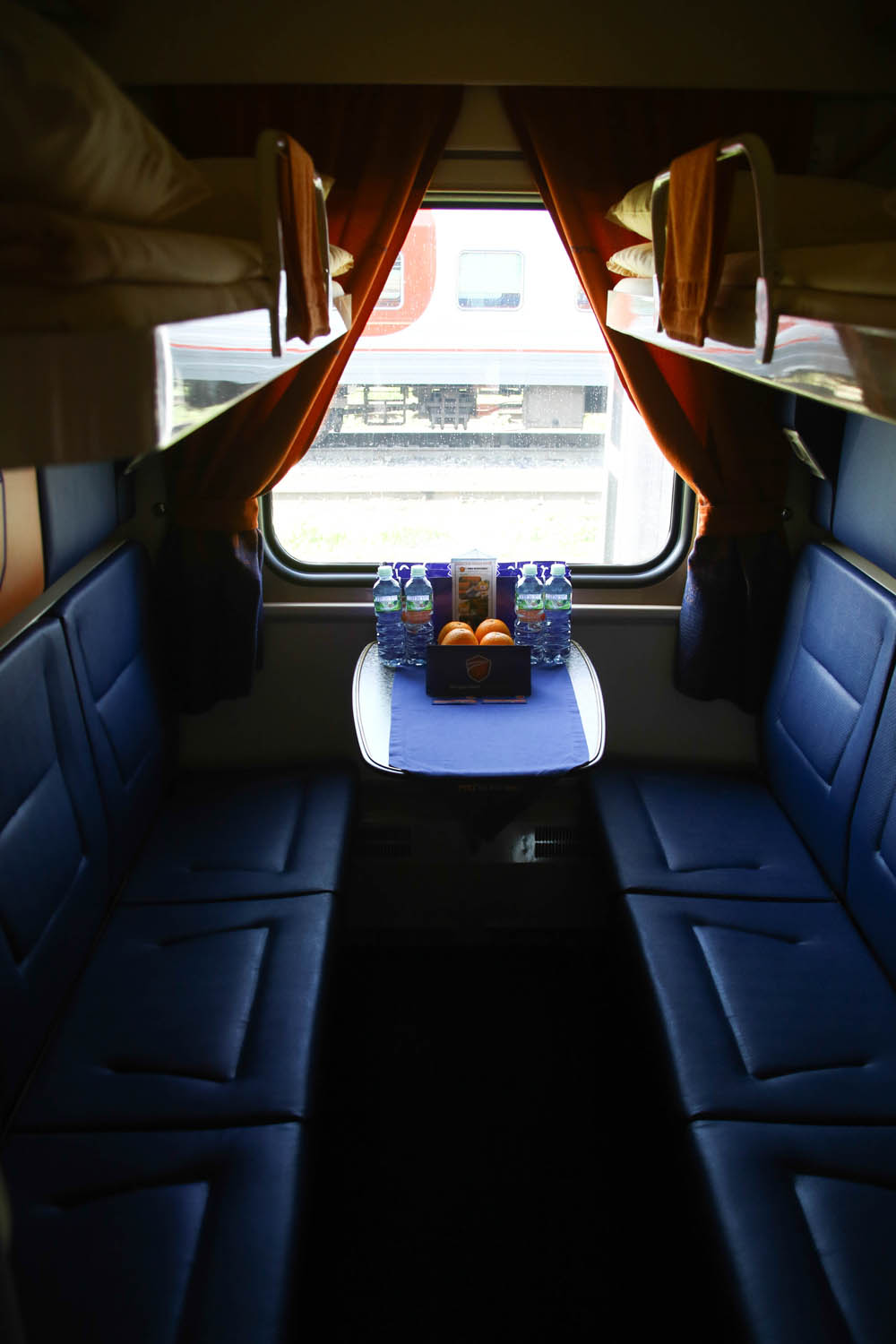
Sofas turn into shelves, on the table by default - water and oranges (oranges are also a signature chip, because the main color of the train is orange):
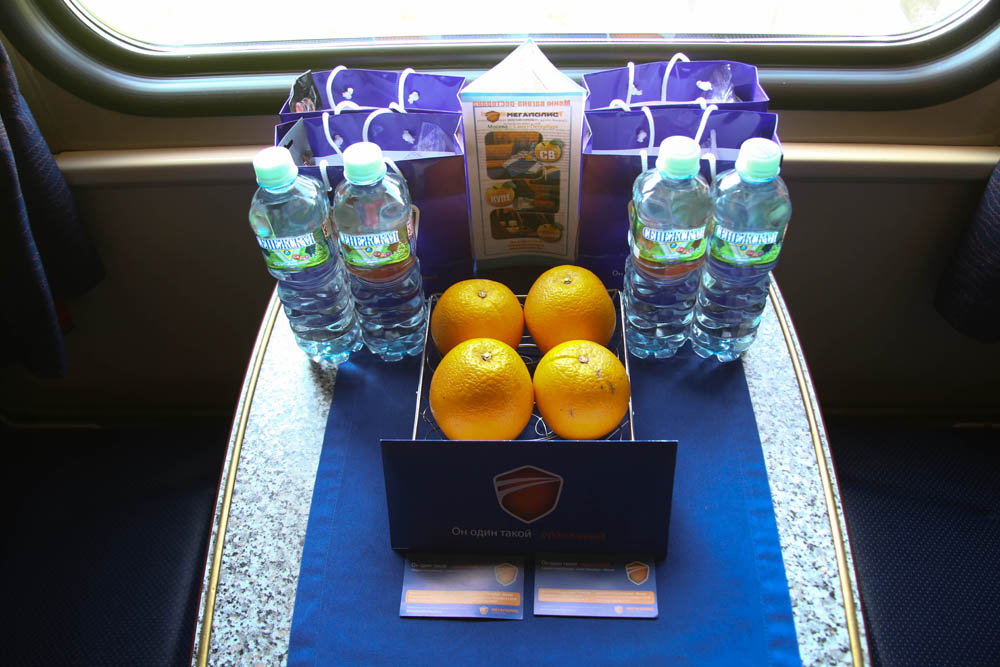
Behind them are snack packets:
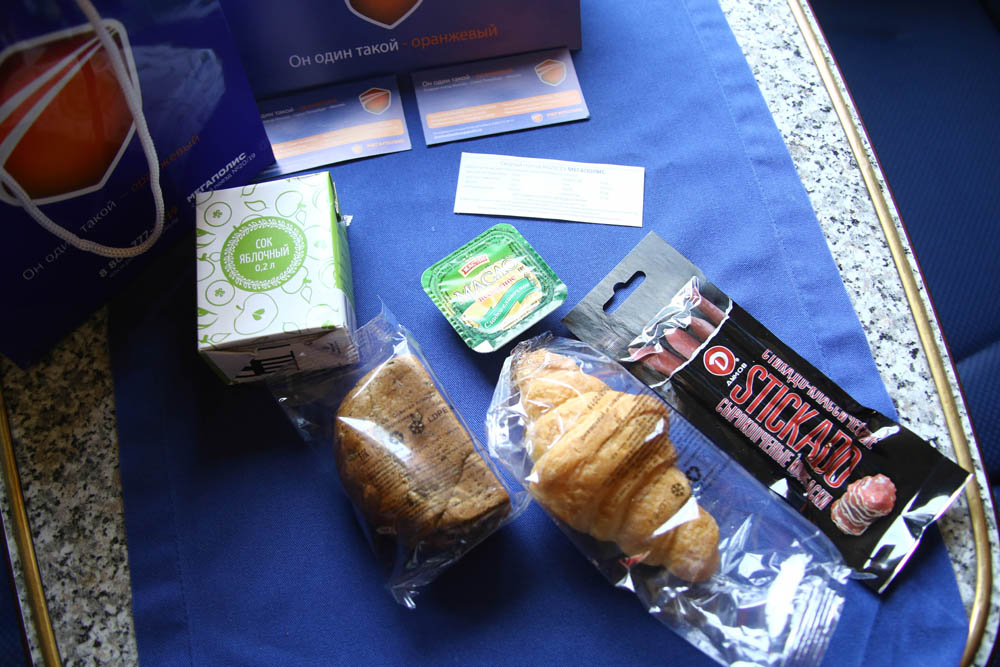
In the corridor we are met by the good old titans:

And cold water taps:

Like closed lockers under the lower shelves - this is legacy.
At the bottom of the cars, power converters for air conditioners are visible:
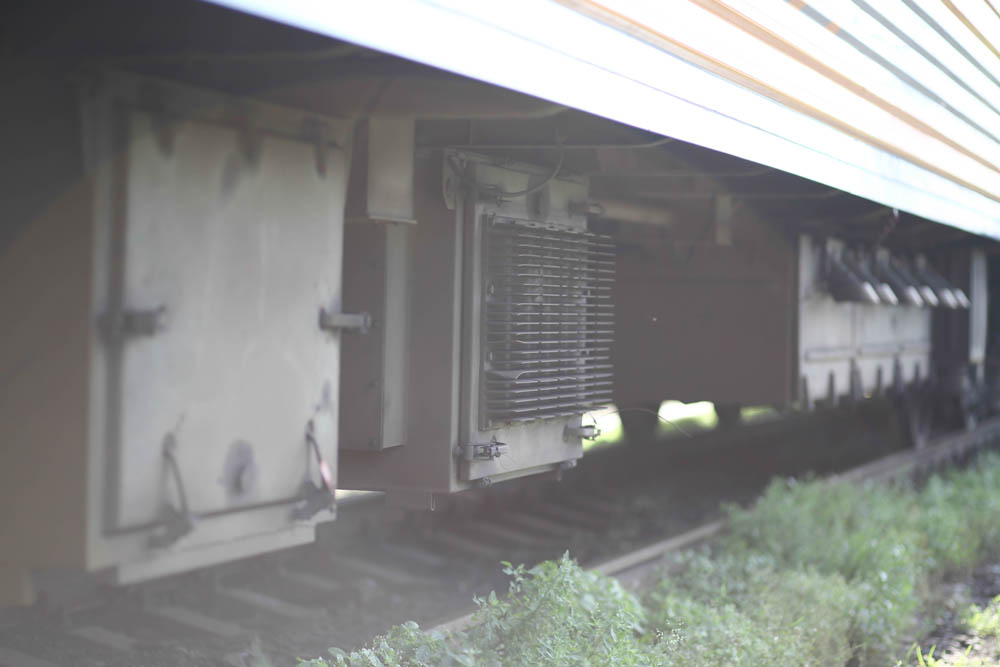
But the coupe is a class higher, only two passengers are traveling here:

Kits are slightly different:

Here are the sockets:

There are USB sockets on the upper shelves of the economy compartment.
There is a TV, it broadcasts from a media server, or you can connect your devices - from a camera to a laptop, here are the outputs at the back:

Hangers are another fixed bug back in 2006. Then, some passengers complained that heavy coats and fur coats were falling from standard coat hanger. These hangers are with wide shoulders and a special friction coating such as soft touch plastic so that the clothes do not slip:
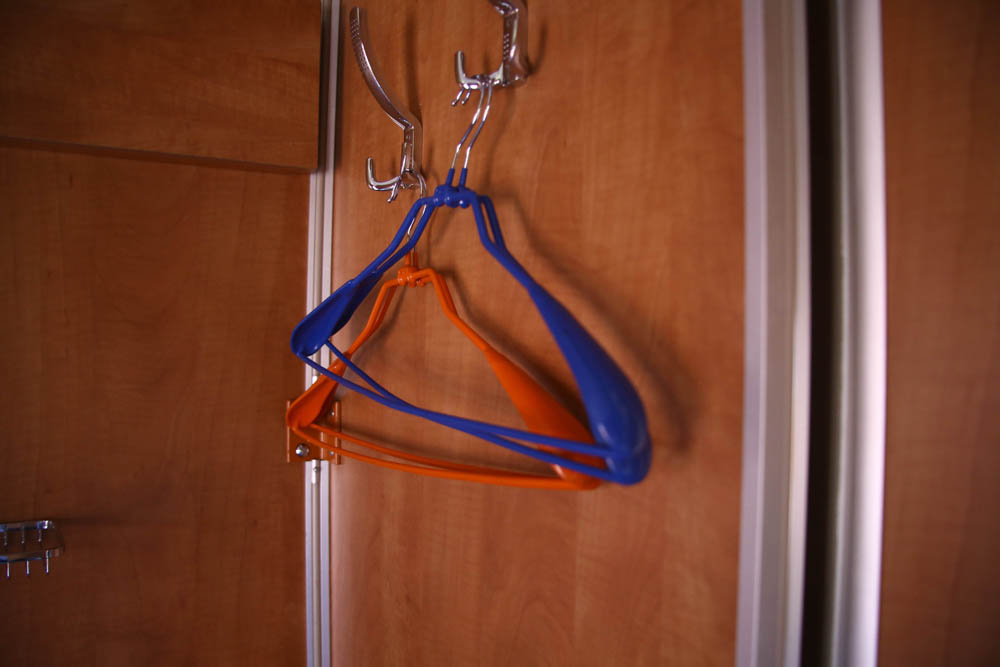
More elements in the compartment:
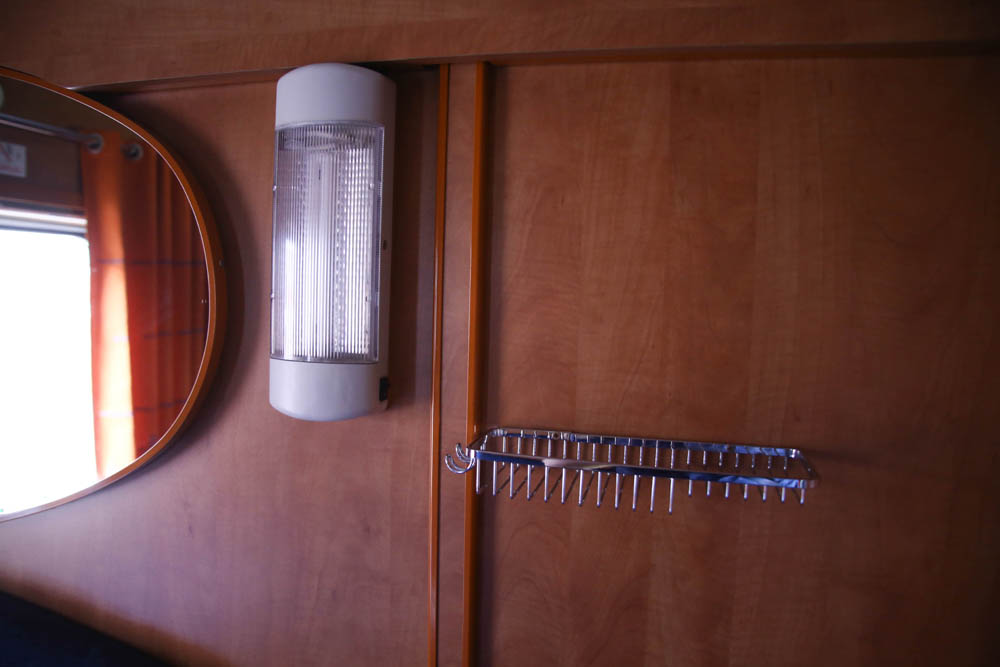
And here pay attention to the patch with the logo of the train:

This is a place that passengers regularly damaged by a ladder, as pictured, on the second shelf. They just sharply raised the lower shelf to get their things, and steamed the upholstery. Now it is much harder to do.

Corridor in the head carriage, compartment and toilet for passengers with reduced mobility.
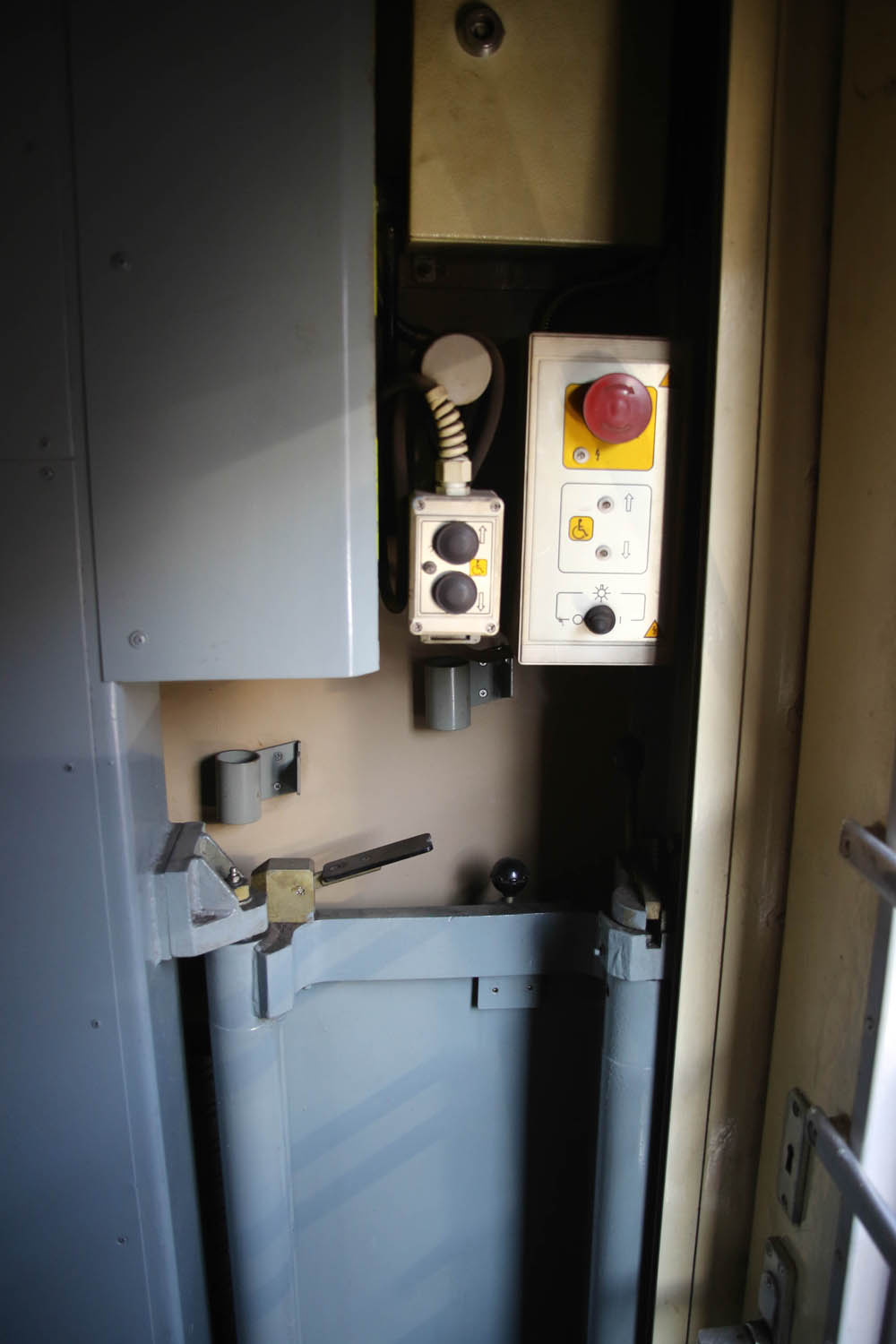
Retractable lifting device in order to be able to enter the train in a wheelchair.
Operation practice
In recent years, a lot of representatives of the fraternal Chinese people began to travel along the Moscow-Petersburg route. The peculiarity with them is that if earlier they were almost always accompanied by guides, now they often put the group on a train in Moscow, show how to sleep, and then meet in St. Petersburg. They are fed somewhere in the city, and therefore they do not have dinner included (this makes the ticket for a travel company cheaper). As a result, some fall asleep right away, and some go looking for adventure and food.
Here is an entry in the book of complaints and suggestions, behind which there is probably some interesting story lost in translation:
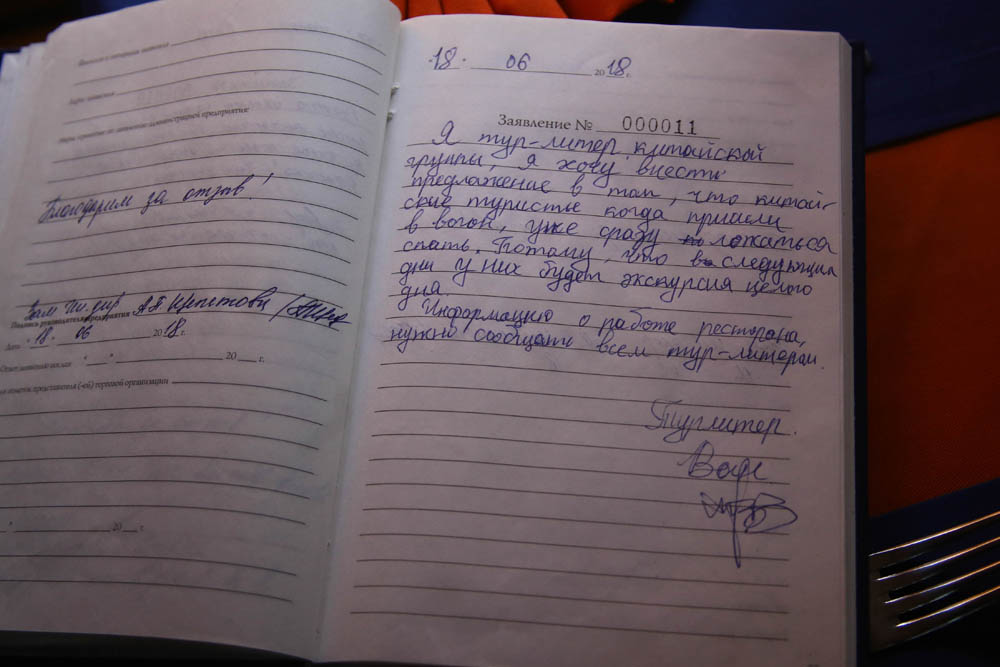
The most unpleasant case was with them: they somehow accidentally lowered the compartment door lock tongue, that is, they locked themselves from the inside with a latch on top. And then they began to suffer distress, to beat and knock from the inside. Explain to them nothing happened. By the time of attempts to find other Chinese in other cars and show them the problem in the next compartment, our heroes were already breaking walls in different directions. As a result, I had to open the casing from the corridor and release them with breakdowns. They smashed the compartment very seriously.
They also, according to the old Chinese habit, sometimes go to the toilet for three: in Chinese reserved seats there is a toilet and a compartment with three washstands.
Especially for the Chinese, the menu has been changed, plus a small brochure with excerpts of the menu in Chinese has been made. They are very fond of breakfast, and from the rest they order only fish and noodles.
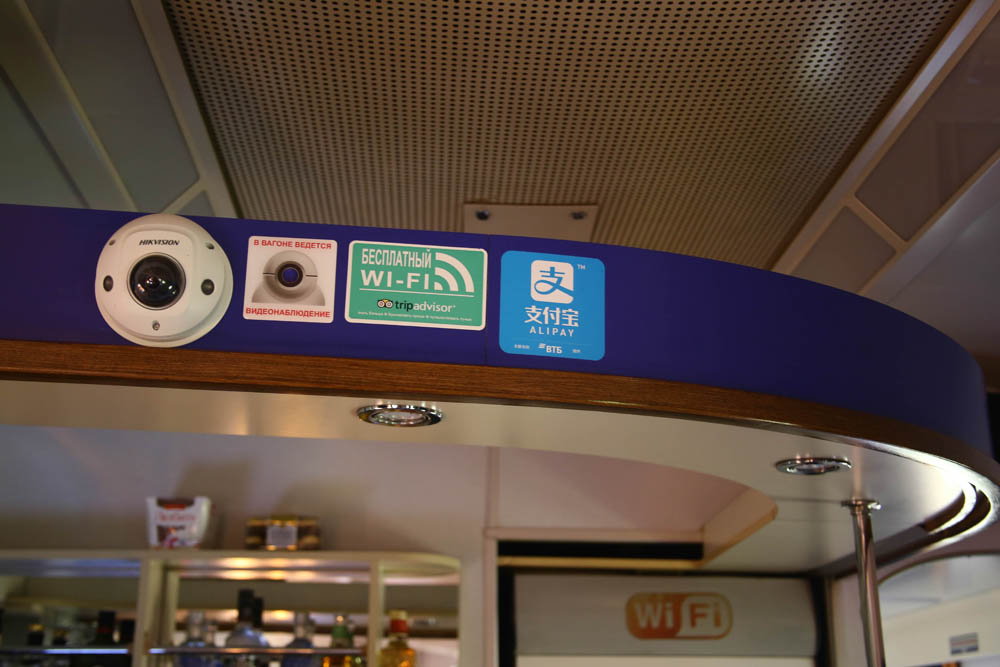
Alipay is already being accepted.
Continuing about the restaurant, it is worth talking about the fact that fried eggs have been removed from the menu. Three egg omelet - please. Fried eggs on request - please. But in the default menu it is not. The reason: it turns out that she, like a steak, someone needs well done, and someone needs medium rare. There were a lot of complaints about the same recipe that the fried eggs were insufficiently fried or overcooked. Therefore, an omelet remained.

Brochure for foreigners.
We tried the taxi service - this is when you can order a car right on the train en route. Not entered: due to the development of applications, they use it a little.
It turned out to be very important to correctly handle forgotten things. A common story: the train stopped, 15 minutes before departure the guides handed things over to the station's locker room for inventory. Then you can pick up forgotten things in the cell for another 30 days. In Megapolis, the procedure is slightly changed. Firstly, there is a round-the-clock hotline, and you can pick up and call there. Passengers often call from the subway. Secondly, the Megapolis runs only along the Moscow - Petersburg route, and there are many return travelers on this route, for example, at night on this train, in the evening back at Sapsan. So, support operators are able to contact the head of the train and specify when and how to pick up the forgotten thing. If at the time of departure the passenger did not ask for his forgotten thing, then she surrenders to the chamber of forgotten things of the station. That is, while the composition is at the point of formation, then you can get things much easier and faster than usual, plus if it is clear who forgot them, they will actively search for you.
Well, the last thing left to show is a small workshop in the staff carriage, equipped for maintenance:
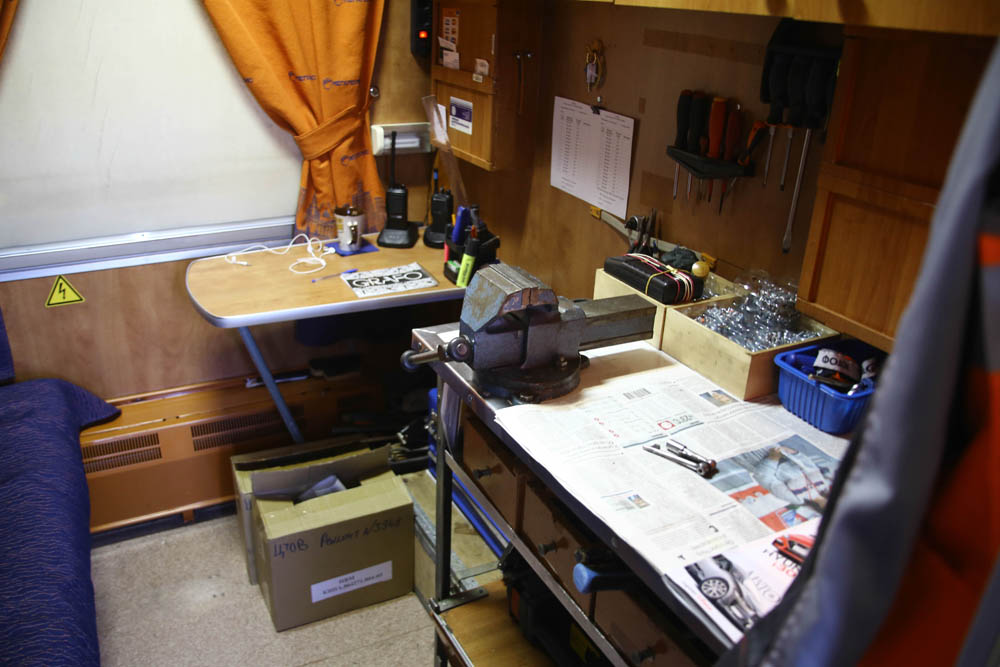
If you are interested in how the headquarters car of the train is arranged and what can happen there, then say: this may deserve a separate post.
That's all for now. Shchepetova Alla Petrovna was with us today:

Deputy General Director for Commerce and Conditions of Carriage, went from a conductor in 1999, then became the head of the train, then became an instructor at the depot, then became the head of the reserve and in 2017 became the deputy general director.
And the head of the train Oleg Anatolyevich Drygin:

It has been operating since 1985: first, on the Kemerovo Railway, then on the Moscow Railway. Launched the "Polar Arrow" and "Megapolis."
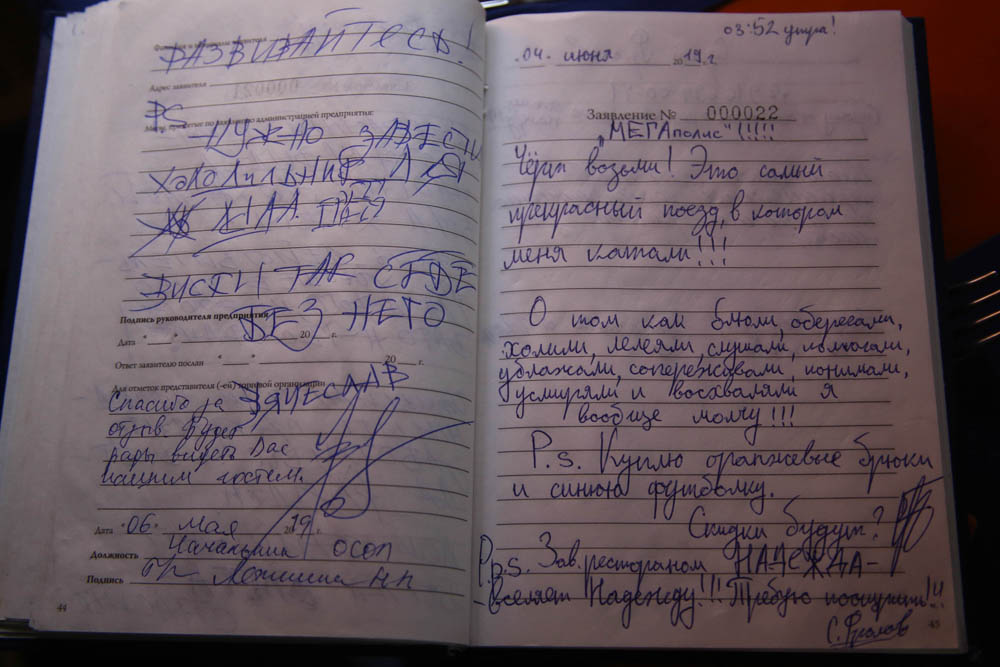
Our other posts about the railway: what’s interesting in the train’s driver’s cabin , especially the Universiade transport , in the Aeroexpress depot , about the trans-Siberian railway, the Grand Express , what trains are there , the wagon’s energy systems , how the passenger wagon is arranged , how the wagons are assembled , how they evolved , about Leningradsky station , about locomotives , about old cars . Great FAQ about long-distance trains and unobvious rules .
All Articles